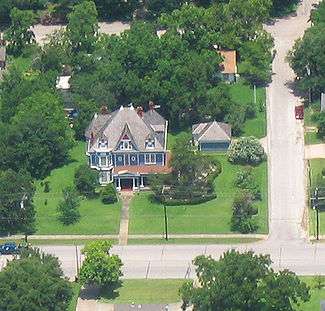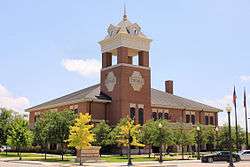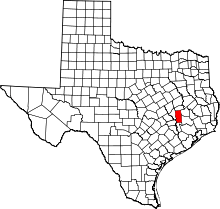Navasota, Texas
| Navasota, Texas | |
|---|---|
| City | |
|
Navasota City Hall | |
| Nickname(s): The Blues Capital of Texas | |
 Location of Navasota, Texas | |
| Coordinates: 30°23′N 96°5′W / 30.383°N 96.083°WCoordinates: 30°23′N 96°5′W / 30.383°N 96.083°W | |
| Country | United States |
| State | Texas |
| County | Grimes |
| Area | |
| • Total | 6.1 sq mi (15.9 km2) |
| • Land | 6.1 sq mi (15.8 km2) |
| • Water | 0.0 sq mi (0.0 km2) |
| Elevation | 217 ft (66 m) |
| Population (2000) | |
| • Total | 7,602 |
| • Density | 1,239.02/sq mi (428.5/km2) |
| Time zone | Central (CST) (UTC-6) |
| • Summer (DST) | CDT (UTC-5) |
| ZIP code | 77868, 77869 |
| Area code(s) | 936 |
| FIPS code | 48-50472[1] |
| GNIS feature ID | 1375099[2] |
Navasota is a city in Grimes County, Texas, United States. The population was 7,049 at the 2010 census. In 2005, the Texas Legislature named the city "The Blues Capital of Texas," in honor of the late Mance Lipscomb, a Navasota native and blues musician.[3]
Location
Navasota is located west of Texas State Highway 6. State Highways 105 and 90 intersect with State Highway 6 in Navasota, with the city located between Houston and College Station, Texas.
History
Navasota was founded in 1831 as the stagecoach stop of Nolansville. Its name was changed in 1858 to Navasota, a name perhaps derived from the Native American word nabatoto (“muddy water”).[1]
After September 1859, when the Houston and Texas Central Railway built into the town, Navasota became important as a shipping and marketing center for the surrounding area. Whereas nearby Washington on the Brazos protested the coming of the rails, the old historic town forfeited its geographic advantage, and it began to decline as many of its businesses and residences began a sure migration to the new railhead across the Brazos River at Navasota.
Slaves were a large part of the local economy, as they were imported, traded and used to work in the many local cotton plantations. Guns were made in nearby Anderson, and cotton, gunpowder, and shoes were made, processed and stored there for the Southern Confederacy during the American Civil War. By 1865 the population was about 2,700. All during the Civil War, all the marketable goods produced in the region were brought to Navasota, then the furthest inland railhead in Texas, to be shipped south to Galveston, where it could be transported by steamboat from the Texas coast and up the Mississippi River to the war effort, or exported to Mexico or overseas to Europe.
Navasota suffered a series of disasters in the mid-1860s that severely depleted its population. In 1865 a warehouse filled with cotton and gunpowder exploded after it was torched by vagrant Confederate veterans; the blast killed a number of people and started a fire that destroyed much of the original downtown, and damaged many buildings, including the post office. Not long afterward the town was struck by a deadly cholera epidemic, which was followed in 1867 by an even more dangerous epidemic of yellow fever. As many Navasota citizens, including the mayor, fled to escape the disease, the town population dropped by about 50 percent.
Mid 1860s skirmish between Navasotan disgruntled freedmen and Confederate veterans broke out in the Brazos Bottoms near Millican, after a race riot there threw the whole region into a panic[citation needed]. An informal militia rallied in Bryan, gathered arms, and caught the train southward towards the angry mob of armed freedmen who were marching on Bryan, a city to the north of Navasota[citation needed]. Many men were left dead and many were wounded after this little known battle, perhaps the greatest race battle ever fought in Texas[citation needed]. This led to the formation of numerous private militias, and ultimately during the late 1860s the KKK in Navasota, and on one occasion a tense confrontation between federal soldiers and a crowd of local white citizens occurred there[citation needed]. Later the White Man’s Union was formed, which sought political solutions when possible to the power struggles in Navasota[citation needed].
During these days, Navasota was considered a wild and wooly place, where it was not considered safe for women and children to go downtown in broad daylight. The downtown buildings were teaming with lawless ruffians, gamblers, prostitutes and drunks. Lawmen had to hide and watch, and often were afraid of the streets at night. There were many saloons and gaming halls, and every Sunday morning the undertaker hitched up the buggy and went downtown to collect the bodies that were anticipated to be there, from another wild Saturday night.
Perhaps the greatest and most publicized violence was around the turn of the century, during the decline of the Populist Party in Grimes County, and the re-election efforts of Populist candidate Garrett Scott for County Sheriff[citation needed]. A man who spent his entire life in Grimes County, Scott had great charm and political skill. He worked extremely well with black population, which in 1900 still maintained a vast majority, as very few former slaves had relocated until violent attacks by White Man's Union organized mobs from Grimes and surrounding counties. Despite resentment in much of the white population, Scott was reelected several times, serving as sheriff for the better part of two decades. During this time a number of black candidates also succeeded in their election efforts. An all white mob flooded into Anderson on November 7, 1900, where they killed Emmett Lee Scott, John I. Bradley, many unnamed black citizens of the county. From the courthouse cupola Sheriff Scott was shot as he crossed the street in front of the Jail. His niece, Nealy Tuck, came out the Jail and threw herself over him to protect him from the rage of bullets that rained down from unseen assailants in the courthouse. The only WMU participant to die was the son of Judge McDonald, William McDonald. The assassination attempt failed initially as Scott was dragged to the jail and survived. There Scott and a large portion of his extended family were pinned down for many days by constant gunfire. Scott's aunt Elizabeth Rowan Scott Neblett implored the governor to intervene. So did Scott's father, John Newton Scott, and his two surviving brothers, postmaster James D. Scott, and Navasota lawman John H. Scott who sent urgent telegrams to the governor explaining how many men and women were "pinned down" in the Anderson Jail with no hope of exiting alive without State Malitia assistance. Scott was badly wounded and would later succumb to the complications that developed while the WMU held the Scott families in the Jail. At least the WMU stopped short of assassinating the Scott women who spread their bodies over their wounded husbands and sons in the militia wagons which carried them to Navasota and by train to Houston. Scott survived long enough to willfully divest his land in the county and to bring a successful lawsuit against every merchant in the county (this was the only way to oppose the secret membership of the WMU as after Nov 7, 1900 to do business in the county belonging to the WMU was required). No murder or assault charges were filed because it was later understood that McDonald shot Emmett Scott point blank in the face as Scott entered Bradley's establishment. Bradley (Emmett Lee Scott's best friend) then shot McDonald and was shot in return fire. The only non WMU witness to this was a severely traumatized teenage Scott girl. All of the other assailants and assassins hid in the courthouse and other buildings, not showing their identities. Following this battle an exodus of blacks from Grimes County to north Texas and beyond into Oklahoma was so profound that the following season it became almost impossible to harvest crops. The county sponsored newspaper ads in the Dallas area beseeching former black residents to return to their "Homes" in Grimes County.
In 1908, Navasota was a lawless boom town, wracked by violence: "shootouts on the main street were so frequent that in two years at least a hundred men died."[3] Twenty-four-year-old Frank Hamer resigned from the Texas Rangers to become the City Marshal and moved in and created law and order.[4] Hamer faced down, chased down, and beat down the Navasota toughs until the streets were quiet, and children could once again go downtown. He relentlessly fought the various power factions, and one day fought one perceived local warlord in the mud on main street, throwing him in jail and defying all comers, as the rest of the troublemakers began to search for cover. He served as marshal until 1911. Hamer became more widely known in 1934 as one of the men who shot Bonnie and Clyde. In 2012, the Navasota city council voted to commission a local sculptor to erect a statue of Frank Hamer in front of the new city hall building.
Present
As of 2014, the population was estimated at 7,351.[4] The industrial sector of the community now boasts 23 companies and over 1200 jobs. In 2009, Navasota was selected as a "Visionaries in Preservation" city by the Texas Historical Commission to protect the numerous historical structures in the city. A new municipal building was completed in 2011 and continued downtown improvements are under construction with completion scheduled in 2013.
Also in 2012, Navasota Municipal Airport completed an expansion to 5000 ft long by 75 ft wide, now allowing jets on the runway. Area residents became fearful of more violence and drugs being flown in. This fear was based on the infamous Navasota area/Mexico drug flights and federal law enforcement arrests of the 1980s.
The City of Navasota earned a 2011 Gold Leadership Award from the Texas Comptroller's Office for efforts in transparency. Its application scored 17 of 20 points. The City of Navasota was one of 70 (out of over a thousand) cities in Texas to receive the Gold status. Also received the award in 2013.. Later it was found out "OCT 2011" from Karen Larue, when she informed the Navasota city council That the Navasota Housing Authority received a zero HUD rating - The new Navasota Housing Authority Executive Director shows that the Audit showed missing funds records and other paper work. Later it was found out that no policy checks had been done for years and year by the city of Navasota.
In 2012, Navasota was named by Union Pacific Railroad as a Train Town USA.[5]
In August 2013, the City of Navasota was named a Go Texan "Certified Retirement Community" by the Texas Department of Agriculture.[6]
Media
Navasota is served by the weekly Navasota Star newspaper, which covers the city of Navasota and its surrounding communities and the Navasota Examiner newspaper, which has been reporting on the goings-on in Grimes County since 1894. The city is also home to the Navasota News 1550 AM, owned and managed by Bryan Broadcasting, which broadcasts the local Navasota Rattlers football games.
In 2013, the British documentary project known as Vague Direction visited Navasota and featured local residents Misslette The Singing Cowgirl and Steve Stribling, a local hog trapper.[7]
Attractions

Navasota has some shops and artisans in its historic downtown district, typified by antique, gift, and junk stores housed in old classic stone and brick structures, and live plays at the Sunny Furman Theatre. Navasota Blues Alley is in the heart of the downtown district, and offers blues memorabilia, museum exhibits, art, vintage music and radios, and much more. The city also has golfing facilities and parks, as well as wineries.
Navasota retains a number of historic Victorian homes on Washington Avenue, the main residential and commercial thoroughfare through town. Another historic edifice is Brule Field, a natural amphitheater built out of native stone by the Great Depression-era Works Progress Administration.[8] It served as the primary grid for the local high school football team, the Navasota Rattlers, until the new stadium was constructed in 2006. Several native-stone churches also remain near downtown, with distinctive Victorian fronts.
The city is also home to two statues of French explorer Rene-Robert Cavelier Sieur de La Salle, including a bronze monument, dedicated in 1936 by the DAR, to celebrate the explorations of the famous French explorer. The second is a stone bust that was previously in downtown, and was rededicated by the French consulate in May 2012 at the August Horst Park. The bust was donated to the city by the French government in 1978. Supposedly, La Salle was murdered by one of his men somewhere near present-day Navasota, while looking for the Mississippi Valley and the way back to French-held lands near the Great Lakes. After numerous voyages, explorations of the Mississippi valley, trading ventures and several mutinies, La Salle’s bones are believed to have found their resting place in the Navasota Valley.
Seasonally, Navasota is visited in the spring for bluebonnets. The Blues Bluebonnets & BBQ music festival is held in April, celebrating the birthday of Mance Lipscomb.[9] A summer festival, the Navasota Bluesfest, every second weekend in August in the Blues Capital of Texas, honors the memory of blues man Mance Lipscomb, who recorded numerous albums and lived in Navasota all of his life. The celebration raises money for college scholarships for local students.[10] A statue of Mance Lipscomb is now a part of Mance Lipscomb Park, near downtown. A statue of Frank Hamer stands in front of city hall, honoring the time he served as city marshal, connecting to the time Mance Lipscomb was his buggy driver. Local artist and sculptor Russell Cushman designed and built the bronze statue. The nearby Texas Renaissance Festival is held near Plantersville in the fall. Also nearby is Washington on the Brazos state park and the George H. W. Bush Presidential Library.
Geography
According to the United States Census Bureau, the city has a total area of 6.1 square miles (16 km2), of which 6.1 square miles (16 km2) is land and 0.16% is water.
Demographics
| Historical population | |||
|---|---|---|---|
| Census | Pop. | %± | |
| 1870 | 1,509 | — | |
| 1880 | 1,611 | 6.8% | |
| 1890 | 2,997 | 86.0% | |
| 1900 | 3,857 | 28.7% | |
| 1910 | 3,284 | −14.9% | |
| 1920 | 5,060 | 54.1% | |
| 1930 | 5,128 | 1.3% | |
| 1940 | 6,138 | 19.7% | |
| 1950 | 5,188 | −15.5% | |
| 1960 | 4,937 | −4.8% | |
| 1970 | 5,111 | 3.5% | |
| 1980 | 5,971 | 16.8% | |
| 1990 | 6,296 | 5.4% | |
| 2000 | 6,789 | 7.8% | |
| 2010 | 7,049 | 3.8% | |
| Est. 2015 | 7,476 | [11] | 6.1% |
As of the census[1] of 2010, 7,049 people, 2,206 households, and 1,726 families resided in the city. The population density was 1,109.7 people per square mile (428.3/km²). The 2,805 housing units averaged 435.0 per square mile (167.9/km²). The racial makeup of the city was 52.4% White, 38.4% Hispanic or Latino, 30.6% African American, 0.5% Native American, 0.4% Asian, and 2.1% from two or more races.
Of the 2,206 households, 37% had children under the age of 18 living with them, 43.5% were married couples living together, 20.8% had a female householder with no husband present, and 29% were not families. About 25.1% of all households were made up of individuals, and 10.4% had someone living alone who was 65 years of age or older. The average household size was 2.81 and the average family size was 3.39.
In the city, the population was distributed as 30.7% under the age of 18, 10.6% from 18 to 24, 26.7% from 25 to 44, 18.0% from 45 to 64, and 12.6% who were 65 years of age or older. The median age was 32.9 years. For every 100 females, there were 86.5 males. For every 100 females age 18 and over, there were 81.0 males.
The median income for a household in the city was $38,000, and for a family was $31,875. Males had a median income of $28,585 versus $21,731 for females. The per capita income for the city was $14,564. About 23.8% of families and 23.7% of the population were below the poverty line, including 34.7% of those under age 18 and 24.0% of those age 65 or over.
Government and infrastructure
The United States Postal Service operates the Navasota Post Office.[13]
The Texas Department of Criminal Justice (TDCJ) operates the O.L. Luther Unit and the Wallace Pack Unit in an unincorporated area in Grimes County near Navasota.[14] In addition, the Pack Warehouse is located in an unincorporated area near the Pack Unit.[15]
Education
The City of Navasota is served by the Navasota Independent School District, Texas Education Agency accountability rankings place Navasota ISD as "Met Standard." More detail at Texas Education Agency website:
The Navasota Rattlers were 3A Div. II State Football Champions in 2012 and 4A Div. I State Football Champions in 2014.
Notable people
- Alvin Ailey, dancer and choreographer
- Kathleen Blackshear, artist
- Jimmy Brown, author of Texas Greed, a book on the Grimes County drug trade from Mexico and South America[16]
- René-Robert Cavelier, Sieur de La Salle, French explorer who was killed in Navasota in 1687
- Clay Condrey, Major League baseball pitcher
- Virgil "Ned" Garvin, Major League baseball pitcher
- Frank Hamer, Navasota city marshal and Texas Ranger
- Christine M. Jones, a former Maryland legislator[17]
- Milt Larkin, musician
- Mance Lipscomb, blues singer
- R. Bowen Loftin, a Texas A&M University president who was a graduate of Navasota High School
- Christopher B. "Stubb" Stubblefield, restaurateur
- Joe Tex, soul musician
- Chuck Norris, American actor and martial artist
See also
- USS Navasota, named after the Navasota River
| Wikimedia Commons has media related to Navasota, Texas. |
References
- 1 2 "American FactFinder". United States Census Bureau. Retrieved 2008-01-31.
- ↑ "US Board on Geographic Names". United States Geological Survey. 2007-10-25. Retrieved 2008-01-31.
- ↑ "Navasota's credentials check out". The Eagle. Retrieved 2015-12-12.
- ↑ "Navasota (city) QuickFacts". quickfacts.census.gov. Retrieved April 20, 2015.
- ↑ "Navasota, Texas Awarded Membership in Union Pacific's Train Town USA Registry". www.uprr.com. Retrieved 2015-12-12.
- ↑ "Navasota". www.retireintexas.org. Retrieved 2015-12-12.
- ↑ "Day 68 – 73: Cleveland To Austin, TX - Vague Direction". Vague Direction. Retrieved 28 April 2016.
- ↑ "Navasota memorabilia for municipal building". The Navasota Examiner. Retrieved 2015-12-12.
- ↑ "Blues, Bluebonnets & BBQ this Saturday in Navasota". navasotaexaminer.com. April 6, 2011. Retrieved April 20, 2015.
- ↑ "Navasota to Host Blues Fest". kbtx.com. August 8, 2014. Retrieved April 20, 2015.
- ↑ "Annual Estimates of the Resident Population for Incorporated Places: April 1, 2010 to July 1, 2015". Retrieved July 2, 2016.
- ↑ "Census of Population and Housing". Census.gov. Retrieved June 4, 2015.
- ↑ "Post Office Location - NAVASOTA." United States Postal Service. Retrieved on May 22, 2010.
- ↑ "Pack Unit." Texas Department of Criminal Justice. Retrieved on May 22, 2010.
- ↑ "Pack Warehouse." Texas Department of Criminal Justice. Retrieved on May 22, 2010.
- ↑ Rosemary Smith (February 2, 2011). "Jimmy Brown writes book about drug history in Grimes County". The Navasota Examiner, Navasota, TX. Retrieved April 20, 2015.
- ↑ "Christine M. Jones".
Bibliography
- Caro, Robert A. (1982). The Years of Lyndon Johnson: Means of Ascent. New York: Knopf. ISBN 0-394-49973-5.
- Sitton, Thad (2000). The Texas Sheriff: Lord of the County Line. Norman and London: University of Oklahoma Press. ISBN 0-8061-3216-7.

